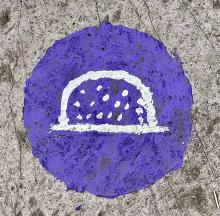Tlatelolco (Mdz6r)
This glyph for the place name Tlatelolco consists of a half-circle, purple mound on a short and wide, white rectangular base. The mound is dotted. This is a tlatelli, also spelled tlatilli.
Stephanie Wood
The locative suffix -co is not shown. The internal element, -ol- has not yet been analyzed; if it is not represented visually, we may need to reclassify this glyph as a compound. The presence of the sand (xalli) that makes up the hillock may substantiate Rémi Siméon's suggestion that Xaltilolco was the original name for the city. See: Tetlacuilolli. Interestingly, the glyph for Tlatelolco in the Codex Telleriano-Rememsis, folio 33 verso, takes the shape of a tepetl), but it is also colored purple. The texturing here, in lieu of dots for sand, are "U" shapes that are reminiscent of the texturing of tlalli. See: Gordon Whittaker, Deciphering Aztec Hieroglyphs (2021), 25, figure 1.8.b.
Stephanie Wood
tlatilulco. puo
Tlatelolco, pueblo
Stephanie Wood
c. 1541, or by 1553 at the latest
Stephanie Wood
hillocks, mounds, mogotes, cerros, pyramids, montículos, pirámides, nombres de lugares
This glyph is painted on a sidewalk that runs through the archaeological site at Tlateloco. This is an example of the contemporary interest in Nahuatl hieroglyphs and the effort to educate the public. Photo by S. Wood, 2 May 2025.

tlatel(li), large mound, https://nahuatl.wired-humanities.org/content/tlatelli
tlatil(li), large mound, https://nahuatl.wired-humanities.org/content/tlatilli
-co (locative suffix), https://nahuatl.wired-humanities.org/content/co
Codex Mendoza, folio 6 recto, https://digital.bodleian.ox.ac.uk/objects/2fea788e-2aa2-4f08-b6d9-648c00..., image 22, of 188.
The Bodleian Libraries, University of Oxford, hold the original manuscript, the MS. Arch. Selden. A. 1. This image is published here under the UK Creative Commons, “Attribution-NonCommercial-ShareAlike 3.0 License” (CC-BY-NC-SA 3.0).


